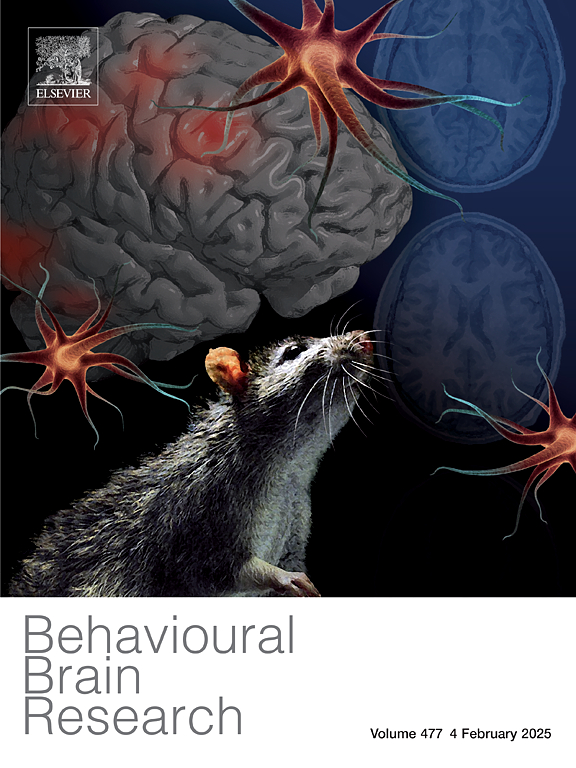EEG microstate as a biomarker of personalized transcranial magnetic stimulation treatment on anhedonia in depression
IF 2.6
3区 心理学
Q2 BEHAVIORAL SCIENCES
引用次数: 0
Abstract
Anhedonia, a core feature of major depressive disorder (MDD), presents significant treatment challenges with conventional methods. Circuit-targeted, personalized repetitive transcranial magnetic stimulation (rTMS) has shown potentiation by focusing on disruptions in specific networks related to anhedonia. However, how rTMS modulates brain network dynamics in anhedonia is not yet fully understood. This research sought to explore these effects using EEG microstate analysis. In this double-blind, randomized, sham-controlled study, resting-state functional MRI was employed to pinpoint the left dorsolateral prefrontal cortex (DLPFC) region that exhibited the strongest functional connectivity to the nucleus accumbens (NAcc), used as the target for rTMS stimulation. Rest-state EEG data from 49 depressive patients with anhedonia(active=26, sham=23) were analyzed both at baseline and after treatment. In addition, a group of 15 healthy participants was included to serve as baseline controls. Resting-state EEG data were collected at baseline and post-treatment. Using polarity-insensitive k-means clustering, EEG microstates were segmented into five categories (A-E). Circuit-targeted rTMS significantly alleviated symptoms of anhedonia and depression. Compared to healthy controls, patients with anhedonia showed reduced microstate B and C occurrence, along with increased microstate D duration. After rTMS targeting the DLPFC-NAcc pathway, the active treatment group exhibited normalization of microstate C occurrence and a reduction in microstate E duration. Notably, the increase in microstate C was significantly correlated with improvements in anticipatory anhedonia, and these changes were observed specifically in treatment responders. The findings suggest that microstate C is linked to anhedonia and could serve as a reliable biomarker for personalized rTMS treatment. These results provide insights into the neural mechanisms underlying rTMS for anhedonia and highlight the potential of EEG microstate analysis in guiding personalized treatment strategies for depression.
脑电图微状态作为个性化经颅磁刺激治疗抑郁症快感缺乏的生物标志物。
快感缺乏症是重度抑郁症(MDD)的一个核心特征,传统方法对其治疗提出了重大挑战。针对回路的个性化重复经颅磁刺激(rTMS)通过关注与快感缺乏相关的特定网络的中断显示出增强作用。然而,rTMS如何调节快感缺乏症的大脑网络动力学尚不完全清楚。本研究试图通过脑电图微状态分析来探索这些影响。在这项双盲、随机、假对照研究中,静息状态功能MRI被用于定位与伏隔核(NAcc)功能联系最强的左背外侧前额叶皮层(DLPFC)区域,该区域被用作rTMS刺激的目标。对49例伴有快感缺乏的抑郁症患者(活动期26例,假期23例)治疗前后的静息状态脑电图数据进行分析。此外,还包括一组15名健康参与者作为基线对照。静息状态脑电图数据采集于基线和治疗后。采用极性不敏感的k-means聚类方法,将脑电微态划分为5类(A-E)。电路靶向rTMS显著缓解快感缺乏和抑郁症状。与健康对照相比,快感缺乏症患者微状态C和D的发生减少,同时微状态D持续时间增加。rTMS靶向DLPFC-NAcc通路后,积极治疗组微状态C发生正常化,微状态E持续时间缩短。值得注意的是,微状态C的增加与预期性快感缺乏症的改善显著相关,这些变化在治疗应答者中特别观察到。研究结果表明,微状态C与快感缺乏症有关,可以作为个性化rTMS治疗的可靠生物标志物。这些结果为rTMS治疗快感缺乏症的神经机制提供了见解,并突出了脑电图微状态分析在指导抑郁症个性化治疗策略方面的潜力。
本文章由计算机程序翻译,如有差异,请以英文原文为准。
求助全文
约1分钟内获得全文
求助全文
来源期刊

Behavioural Brain Research
医学-行为科学
CiteScore
5.60
自引率
0.00%
发文量
383
审稿时长
61 days
期刊介绍:
Behavioural Brain Research is an international, interdisciplinary journal dedicated to the publication of articles in the field of behavioural neuroscience, broadly defined. Contributions from the entire range of disciplines that comprise the neurosciences, behavioural sciences or cognitive sciences are appropriate, as long as the goal is to delineate the neural mechanisms underlying behaviour. Thus, studies may range from neurophysiological, neuroanatomical, neurochemical or neuropharmacological analysis of brain-behaviour relations, including the use of molecular genetic or behavioural genetic approaches, to studies that involve the use of brain imaging techniques, to neuroethological studies. Reports of original research, of major methodological advances, or of novel conceptual approaches are all encouraged. The journal will also consider critical reviews on selected topics.
 求助内容:
求助内容: 应助结果提醒方式:
应助结果提醒方式:


